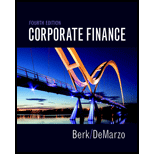
A bicycle manufacturer currently produces 300,000 units a year and expects output levels to remain steady in the future. It buys chains from an outside supplier at a price of $2 a chain. The plant manager believes that it would be cheaper to make these chains rather than buy them. Direct in-house production costs are estimated to be only $1.50 per chain. The necessary machinery would cost $250,000 and would be obsolete after 10 years. This investment could be
If the company pays tax at a rate of 35% and the
Trending nowThis is a popular solution!

Chapter 8 Solutions
Corporate Finance Plus MyLab Finance with Pearson eText -- Access Card Package (4th Edition) (Berk, DeMarzo & Harford, The Corporate Finance Series)
Additional Business Textbook Solutions
Horngren's Financial & Managerial Accounting, The Financial Chapters (Book & Access Card)
Operations Management
Fundamentals of Management (10th Edition)
Advanced Financial Accounting
Horngren's Accounting (12th Edition)
Business Essentials (12th Edition) (What's New in Intro to Business)
- TASK DESCRIPTION This assignment is comprised of two discrete tasks that each align with one of the learning outcomes described above. One is an informal report based on a five-year evaluation of the financial management and performance of a London Stock Exchange (LSE) FTSE 100 listed company. This report relates to learning outcome one. The second task, covering learning outcome two, is an essay on a particular aspect of financial-decision making and the main issues and theoretical frameworks related to the topic. Task one (Informal business report) Students are required to choose a public listed company from a given list of familiar United Kingdom (UK) firms whose shares are traded on the London Stock Exchange's FTSE 100 index, download its most recent annual report(s) covering financial statements for the past five years, and from the data presented produce an informal report of approximately 3,000 words which includes a critical overall analysis of its financial performance over…arrow_forwardAnswer should be match in options. Many experts are giving incorrect answer they are using AI /Chatgpt that is generating wrong answer.arrow_forwardplease select correct option of option will not match please skip dont give wrong answe Answer should be match in options. Many experts are giving incorrect answer they are using AI /Chatgpt that is generating wrong answer. i will give unhelpful if answer will not match in option. dont use AI alsoarrow_forward
- The YTMs on benchmark one-year, two-year, and three-year annual pay bonds that are priced at par are listed in the table below. Bond Yield 1-year 2.39 2-year 3.11 3-year 3.52 What is the three-year spot rate for no-arbitrage pricing? Enter answer in percents.arrow_forwardAnswers for all the questionsarrow_forwardHello experts Answer should be match in options. Many experts are giving incorrect answer they are using AI /Chatgpt that is generating wrong answer. i will give unhelpful if answer will not match in option. dont use AI alsoarrow_forward
- 3. Owen expects to receive $20,000 at the beginning of next year from a trust fund. If a bank loans money at an interest rate of 7.5%, how much money can he borrow from the bank based on this information? A. $12879.45 B. $12749.67 C. $15567.54 D. $174537.34arrow_forwardTASK DESCRIPTION Children educatio Personali Cross- n ty cultural Spouse's willingne allowanc ss to travel Spouseoverseas job assistanc compete Prior ncies internati onal experienc Age Host country housing assistanc Income tax equalisati on policy Overseas health care plan Length of the foreign assignme Career nt and repatriati Receptivity to Internation al Careers Family status Gender Marital status Educatio n Destinati Opportun on on Company ities for country planning culture career support (Tarique et al., 2015) Tarique et al. (2015) developed the receptivity to international careers framework. Reflecting on generational differences in contemporary organisations, you are required to evaluate this model critically by addressing the following: 1. Identify the factors that are more important to Gen X, Gen Y, and Gen Z in their receptivity to international assignments. (1,500 words) 2. Critically discusses how factors such as culture, personality and skills/experience may impact…arrow_forwardListen Answer should be match in options. Many experts are giving incorrect answer they are using AI /Chatgpt that is generating wrong answer. i will give unhelpful if answer will not match in option. dont use AI alsoarrow_forward
- Please Answer should be match in options. Many experts are giving incorrect answer they are using AI /Chatgpt that is generating wrong answer. i will give unhelpful if answer will not match in option. dont use AI alsoarrow_forwardAnswer should be match in options. Many experts are giving incorrect answer they are using AI /Chatgpt that is generating wrong answer. i will give unhelpful if answer will not match in option. dont use AI alsoarrow_forwardToodles Inc. had sales of $1,840,000. administrative and selling expenses, and depreciation expenses were Cost of goods sold, $1,180,000, $185,000 and $365,000 respectively. In addition, the company had an interest expense of $280,000 and a tax rate of 35 percent. (Ignore any tax loss carry-back or carry-forward provisions.) Arrange the financial information for Toodles Inc. in statement and compute its OCF? an incomearrow_forward
- Principles of Accounting Volume 2AccountingISBN:9781947172609Author:OpenStaxPublisher:OpenStax College
